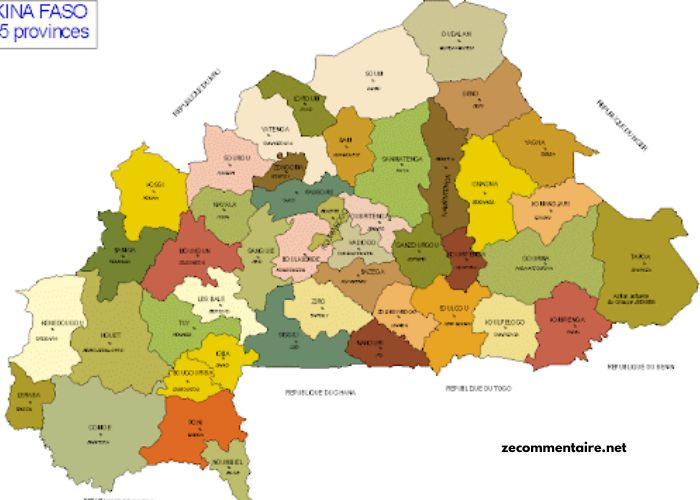Burkina Faso, a landlocked country in West Africa, is a nation rich in culture, history, and geographical diversity. The Carte Du Burkina Faso is an essential tool for understanding the country’s layout, highlighting key regions, cities, and landmarks that define this African nation. From its capital, Ouagadougou, to its diverse provinces and natural landscapes, the Carte Du Burkina Faso provides a detailed and accurate representation of the country’s geography, helping travelers, researchers, and residents navigate the land with ease.
For anyone looking to delve deeper into the geographical features and administrative divisions of Burkina Faso, the Carte Du Burkina Faso is an invaluable resource. It not only showcases the country’s topography but also serves as a guide for those interested in the political boundaries and economic hubs. This map is used in various contexts, from educational purposes to tourism planning and even for governmental functions.
What Is the Significance of Carte Du Burkina Faso?
The Carte Du Burkina Faso plays a pivotal role in understanding the country’s geographical makeup. It serves as a visual representation of the political and physical divisions of Burkina Faso, helping users identify key regions, roads, cities, and landmarks. The map is crucial for students, professionals, and travelers alike, as it allows them to gain a clearer picture of the country’s terrain and administrative layout.
Geographically, Burkina Faso is characterized by a mix of savannah, plains, and mountainous areas. The Carte Du Burkina Faso highlights these features, allowing people to understand the distribution of natural resources, agricultural land, and urban areas. Whether for academic research, political analysis, or travel planning, the Carte Du Burkina Faso is an indispensable tool that provides essential data about the country’s landscape.
How Can Travelers Use the Carte Du Burkina Faso?
For travelers, the Carte Du Burkina Faso is more than just a map; it is a guide to exploring the country. The map helps visitors navigate the various regions, from the bustling city of Ouagadougou to the more rural provinces and natural reserves. With the Carte Du Burkina Faso, travelers can plan their routes, understand distances between cities, and find key points of interest, such as national parks, cultural sites, and historical landmarks.
Travelers can also use the Carte Du Burkina Faso to learn about the country’s infrastructure, including roads, highways, and airports, ensuring smooth transit across the nation. Whether embarking on a road trip or exploring the less accessible areas of the country, the Carte Du Burkina Faso offers vital information to help tourists make informed decisions about their journeys. In addition, the map provides essential insights into local customs and geographical features that might influence travel plans.
What Does the Carte Du Burkina Faso Show?
The Carte Du Burkina Faso illustrates a variety of geographical and administrative features. It details the 13 regions that make up the country, each with its own unique cultural identity and economic importance. The map also showcases major cities, such as Ouagadougou, Bobo-Dioulasso, and Koudougou, which serve as key economic and cultural hubs.
In addition to political divisions, the Carte Du Burkina Faso highlights important rivers, mountains, and natural reserves that are significant to the country’s ecosystem. The map also depicts major roads, providing valuable insights into the country’s transport infrastructure. For those interested in the historical or environmental aspects of Burkina Faso, the Carte Du Burkina Faso is an excellent resource for understanding the relationship between the geography and development of the country.
How Accurate Is the Carte Du Burkina Faso?
Accuracy is crucial when it comes to maps, and the Carte Du Burkina Faso is highly regarded for its precision and reliability. The map is regularly updated to reflect changes in infrastructure, population density, and political boundaries. This makes it a trustworthy source for anyone looking to gain an up-to-date understanding of the country’s geography.
Cartographers and geographers use the most advanced technologies, such as satellite imagery and GIS (Geographic Information Systems), to ensure that the Carte Du Burkina Faso is as accurate as possible. Whether used by government officials, researchers, or tourists, the map provides a clear and detailed representation of the country’s layout, allowing users to make informed decisions based on accurate data.
How Is the Carte Du Burkina Faso Used in Education?
In education, the Carte Du Burkina Faso serves as an important tool for teaching geography, history, and cultural studies. Schools across the country use this map to help students learn about Burkina Faso’s regions, cities, and topographical features. The map is a key resource for understanding the country’s political structure and its role within the broader West African context.
Educators use the Carte Du Burkina Faso to engage students in discussions about geography, local communities, and the environment. By studying the map, students gain a deeper appreciation for the diverse cultures and landscapes that define Burkina Faso. This understanding is vital for fostering national pride and encouraging active participation in the country’s development.
How Has the Carte Du Burkina Faso Evolved Over Time?
The evolution of the Carte Du Burkina Faso reflects the country’s changing political and geographical landscape. Originally created as a tool for administrative purposes, the map has undergone significant changes over the years to accommodate new boundaries, cities, and infrastructure. The most notable changes have occurred since Burkina Faso’s independence in 1960, when the country’s political and economic priorities shifted.
Today, the Carte Du Burkina Faso is more comprehensive than ever, offering detailed insights into the country’s regions, rivers, roads, and mountains. As the country continues to develop, the map will likely continue to evolve, incorporating new data and reflecting the growing importance of urbanization, infrastructure development, and natural resource management. The historical changes in the Carte Du Burkina Faso provide valuable context for understanding the country’s progress and challenges.
Conclusion
In conclusion, the Carte Du Burkina Faso is an essential tool for understanding the geography, politics, and development of the country. Whether used for travel, education, or research, the map provides crucial information that helps individuals navigate the diverse landscapes of Burkina Faso.
From its detailed representation of regions, cities, and natural features to its historical evolution, the Carte Du Burkina Faso remains a key resource for anyone interested in the country. By providing an accurate and comprehensive overview of Burkina Faso’s geography, the map plays a vital role in the ongoing development and understanding of this unique West African nation.




